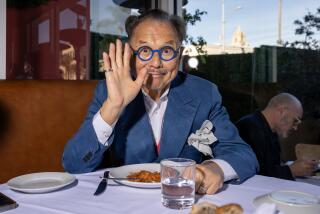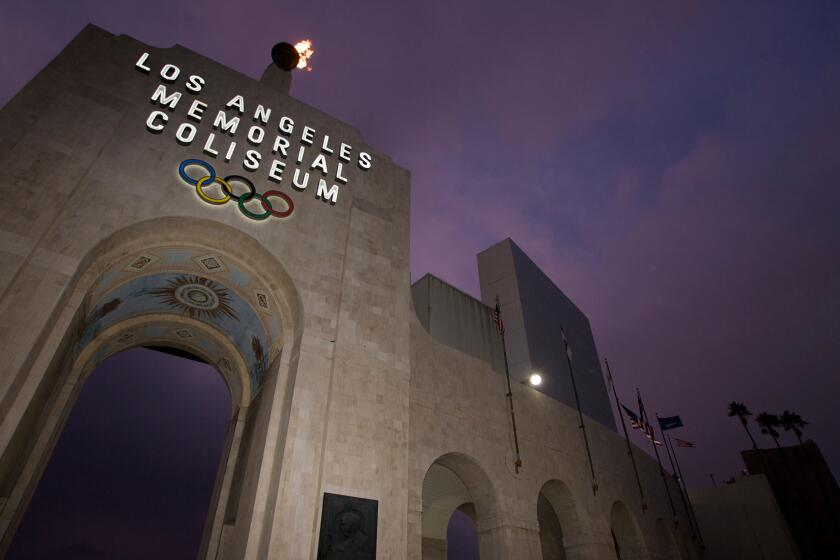Seeking to send a sport soaring
Don Chew leaned in close, crinkled his nose and offered a Cheshire smile that threatened to envelop his face. Yes, he said, he is well aware that his grand dream -- a foreign man pioneering badminton, a foreign sport, in a foreign land -- has been preposterous from the start. But, he said, here’s the thing: “It’s all coming true.”
Chew’s American tale has its roots in his native Thailand. It incorporates faces from Laos, Vietnam, China, Malaysia and Indonesia. It takes place along the industrial northern tip of Main Street in the city of Orange.
There, you’ll find a cinder block wholesaler, a cement factory and a metal-cutting shop -- and one large, pink, L-shaped compound. This is Chew’s peculiar empire, and on a recent morning, it was, literally and figuratively, running on all cylinders.
Literally, the cylinders were churning and groaning inside the machinery of K&D Graphics, the printing company Chew founded in his garage in 1981.
On this day, like most others, his 55 employees were feverishly printing, folding, collating and stapling -- 60,000 Jenny Craig “Dining Out Success Guides,” 17,000 Yonex tennis catalogs, 70,000 Kawasaki catalogs. Thirteen 25,000-foot rolls of paper were being hustled across a warehouse floor to make room for Chew’s latest toy, an approximately $9-million, 125-foot-long printing press he designed himself.
All of that would be plenty for most, but Don Chew is not most, and that’s where his more figurative feats begin. The printing business is one of three enterprises on the compound. Bebe’s Cafe, his 95-seat restaurant, named for his daughter, is out front. And between the restaurant and the presses is his life’s true passion: a virtual temple to badminton, which he says saved his life.
In three weeks, the Badminton World Federation will freeze the world rankings in each of the sport’s events -- men’s and women’s singles, men’s and women’s doubles and mixed doubles -- and issue invitations to the 2008 Summer Olympics in Beijing.
Much of the world will be holding its breath. Not so the United States, except at Chew’s compound, which is, effectively, the de facto training center for this nation’s small, obscure group of world-class badminton players.
This year, the United States could place athletes in all five events: Howard Bach, 29, and Khan “Bob” Malaythong, 27, in men’s doubles; Bach and Eva Lee, 21, in mixed doubles; Lee and Mesinee “May” Mangkalakiri, 24, in women’s doubles; Lee in women’s singles; and Raju Rai, 24, in men’s singles. All, like Chew, 67, are U.S. citizens.
That success would mark another milestone in Chew’s remarkable odyssey.
“We got lucky,” he said the other day. “Good employees. Hard work.”
“Yes,” said his wife of 43 years, Kim Chew, his former mixed doubles badminton partner and the “K” in “K&D Printing.” “But he is also, to some degree. . . .”
Bebe Chew, their daughter, did not look up from her computer.
“Crazy,” she said with a laugh. “A little crazy.”
To the extent that most Americans have played badminton at all, it has typically taken place in someone’s backyard, often with a racket in one hand and a beer in the other. It can be a little startling to see the real thing.
It is played indoors, on a court that resembles a small tennis court, at a frenetic pace. Top players can smash the shuttlecock -- a “birdie” made of cork and goose feathers -- at speeds approaching 200 mph.
The game requires power and tact; top players can return those smashes, depositing them deftly to within an inch of the line on the other side of the net.
The game has virtually no exposure in the United States. Olympic hopeful Mangkalakiri said that when she returned recently from a six-country tour of qualifying tournaments in Europe, a customs agent asked her what she’d been up to. “He said: ‘I didn’t even know people played competitive badminton,’ ” she said with a laugh.
In many other countries, badminton tournaments are jammed, tickets are scalped for exorbitant prices and players are treated, Mangkalakiri said, “like Kobe Bryant.”
Chew never made it to that level of the sport as a young man in Thailand. But he tried, as a teenager, and it was a seminal decision.
“Back then, I had four or five guys around me all the time,” Chew said. “We’d stay up late. Roam around. Fight in the street.”
Badminton, he said, taught him discipline. He quit drinking, quit smoking. Still in high school, he began working alongside his father at the port authority in Bangkok. He became such a workaholic that a few years later, after he’d taken a job selling diagnostic machines, when his family home burned to the ground in the middle of the night, Chew borrowed clothes from a neighbor before dawn and reported to work as usual.
“He became so determined,” Kim Chew said. “The game taught him how to win and how to lose.”
By 1972, however, his small printing business was foundering as the Vietnam War eroded the region’s economy. He immigrated to Southern California, first earning $2.75 an hour staffing a conveyor belt at a beverage factory. In 1981, while working for a medical services printing company, he persuaded a friend to loan him $5,000 for the down payment on a small printing press, which he set up in his garage.
He started printing business cards and letterhead and soon talked his way into larger accounts.
“I was still working my other job,” he said. “I would get home, start printing and print until morning. I would turn it off, go upstairs, shave and go to work.”
He soon quit his “other” job. With his wife and three children -- who all mastered the art of printing as young teens -- he poured himself into the business. They bought a four-color press, then a six-color press, then their first building in 1987.
By the mid-1990s, he was doing $6 million in sales and had his eye on a strawberry farm on Main Street. In 1994, he bought it for $1 million in cash.
Today, he and Kim, their three children and six grandchildren live a few miles away, in three of the five houses on a single block in Orange. There are 12 more relatives on the payroll. The company expects to handle about $11 million in sales this year.
But the heart of his 78,000-square-foot empire is the 12-court Orange County Badminton Club.
Its floors, built of Danish beechwood, rest atop a 2-inch cushion designed to save the knees of the athletes. The gym is temperature controlled, and since traditional ventilation would require air flow that would disrupt the natural arc of shuttlecocks, Chew designed a special air-conditioning system that uses giant, gentle vents lining each of the walls.
There have been numerous frustrations.
Chew bickers frequently with the U.S. Olympic Committee, which devotes very little money to the sport. He props it up the rest of the way, spending $490,000 last year on coaches’ salaries, players’ travel and more, leading some to dub him the godfather of American badminton.
The family wants to broaden awareness of the sport, but corporate sponsors have been slow to respond. His efforts to introduce badminton into local schools in an attempt to expand his base beyond Asian Americans have been fruitless. Without a broader base of elite athletes, the level of competition can’t rise. As it is, U.S. players who make the Olympics expect to struggle against athletes from nations where badminton is a phenomenon and a lifestyle -- Indonesia, China, Korea, Denmark.
But these Olympics, he figures, are still just the beginning. His highest hopes rest with two players who aren’t old enough to qualify this year. Both, predictably, are relatives: a 14-year-old niece, Cee Ketpura, who has never lost a match in her age group; and 13-year-old grandson Phillip Chew, whom Don Chew calls the “Tiger Woods of badminton.”
“Olympic gold for the U.S. That is the ultimate dream,” he said. “People tell me I’m crazy. But I never give up. Never.”
More to Read
Sign up for Essential California
The most important California stories and recommendations in your inbox every morning.
You may occasionally receive promotional content from the Los Angeles Times.









